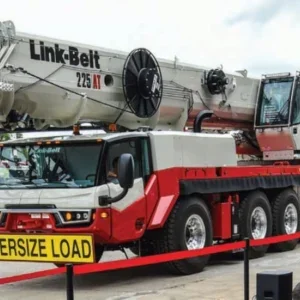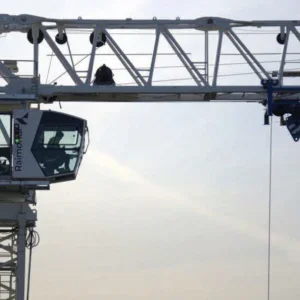Grove opened the doors of its Shady Grove factory in Pennsylvania, USA in the first week of October, not just to celebrate the successful financial restructuring of the company, but also to show off its new flagship rough terrain model, the RT 9000E.
This machine, rated at 115t (130 US ton) is the largest rough terrain crane on the market and has a five section, full power boom that extends from 12.8m to 48.7m (42ft to 260ft). The boom shape is the ovoid Megaform, familiar from Grove’s German-built GMK all-terrain product, rather than the old fashioned trapezoidal booms of Grove’s earlier RT series. It is basically the same boom as the one on the 100t GMK 5100, except with full power rather than the Twinlock pinning system. The original idea was to use a pinned boom but market research showed that customers prefer a full power boom on RTs.
Grove says the RT 9000E offers ‘exceptional mobility, manoeuvrability and pick-and-carry capabilities not previously available on the job site’ and expects it to compete with crawler cranes. Three pre-production units have been built, with the first one going out for field trials with customers next month. Production starts next year.
The crane offers a maximum tip height of 52m (169ft) on the main boom, and a 36.6m (140ft) maximum radius with 1.71t (3,770lb) capacity. A standard 11m to 18m (36ft-59ft) lattice bifold extension is offsettable at 0°, 20° and 40°. An option, seen on recent GMK models, is a bifold swingaway that luffs hydraulically from 0° to 40°. This extension is also 11m to 18m (36ft-59ft).
Two 8m (26ft) lattice inserts give a maximum tip height of 85m (279ft). This compares with a maximum height under hook of 62.5m for Grove’s previous biggest RT, the 90t (100 US ton) RT 9100. Previous longest RT boom was 45.5m (149ft 3in) on the Terex RT 1100, which has a maximum tip height of 75m (246ft). The market for this RT class in North America is only about 15 units a year, but Grove has its eyes on the Middle East, as well as North America, for the RT 9000E.
In addition to the hydraulic luffer, another new feature brought over from the GMK range is a tilting cab. Otherwise, the cab is the same as Grove’s other recent E series RTs. Along with a full LMI system, the crane includes as standard a work area definition system that allows the operator to programme in safe working limits, to avoid hitting nearby obstacles, such as power lines.
To aid transportation the outrigger boxes are hydraulically pinned, design to disconnect quickly. The standard 10,886kg (24,000lb) counterweight is hydraulically installed, as is the optional 7,257kg (16,000lb) counterweight which consists of two sections. Fully equipped, the machine weighs 80.25t (176,934lb). Stripping off the boom, bifold jib, block and ball, counterweight, auxiliary hoist, rope and outrigger boxes leaves a unit weighing 33t (72,649lb). The RT 9000E, which comes with a 10 year structural warranty, has an overall length of 16.15m (53ft), an overall height of 4.14m (13ft 7.5in) and an overall width of 3.8m (12ft 5in). Chassis length is 9.7m (31ft 10in) with outrigger boxes and 8.13m (26ft 8in) without them.
This machine will be exhibited at Conexpo in Las Vegas next year, where it will compete for attention with a crane currently going through final development at Grove, the GMK 7450, a seven-axle all-terrain and the new flagship of the Grove fleet.
Also at Conexpo might be Link-Belt’s biggest ever RT model, in the 100 US ton capacity region. Details of this machine are being kept heavily under wraps but it is understood that Link-Belt has adopted an innovative design to address some of the problems faced by users of the biggest RTs.






